War in Heaven
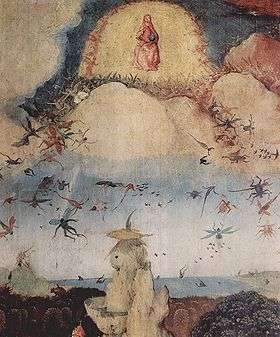
The Book of Revelation describes a war in heaven between angels led by the Archangel Michael against those led by "the dragon", identified with "the devil and Satan", who are defeated and thrown down to the earth.[1][2] Revelation's war in heaven is related to the idea of fallen angels, and possible parallels have been proposed in the Hebrew Bible and the Dead Sea Scrolls.
Revelation 12:7–13
| Christian eschatology |
|---|
| Eschatology views |
|
Contrasting beliefs |
|
Biblical texts
|
|
Key terms
|
| Christianity portal |
Modern Bible commentators view the "war in heaven" in Revelation 12:7–13 as an eschatological vision of the end of time or as a reference to spiritual warfare within the church, rather than (as in Milton's Paradise Lost) "the story of the origin of Satan/Lucifer as an angel who rebelled against God in primeval times."[3][4][5][6] Some Christian commentators have seen the war in heaven as "not literal" but symbolic of events on earth.[7][8]
In Milton's Paradise Lost (1674), the angel Lucifer leads a rebellion against God before the Fall of Man. A third of the angels are hurled from Heaven, including pagan gods such as Moloch and Belial.[9]
Jonathan Edwards said in his sermon Wisdom Displayed in Salvation: "Satan and his angels rebelled against God in heaven, and proudly presumed to try their strength with his. And when God, by his almighty power, overcame the strength of Satan, and sent him like lightning from heaven to hell with all his army; Satan still hoped to get the victory by subtilty".[10]
In the Catholic Encyclopedia (1911) article "St. Michael the Archangel", Frederick Holweck wrote: "St. John speaks of the great conflict at the end of time, which reflects also the battle in heaven at the beginning of time." He added that Michael's name "was the war-cry of the good angels in the battle fought in heaven against the enemy and his followers."[11]
The Church of Jesus Christ of Latter-day Saints (LDS Church) teaches that Revelation 12 concerns an actual event in the pre-mortal existence of man. The Book of Moses, included in the LDS standard works, references the War in Heaven and Satan's origin as a fallen angel of light.[12] This image of a war in heaven at the end of time became added to the story of a fall of Satan at the beginning of time, including not only Satan but a third of all angels as well, referred to in the phrase "the dragon and his angels".[13]
Anatole France in the 1914 novel La Revolte des Anges adapted the Christian myth to make a parable about revolts and revolutionary movements.
Motif
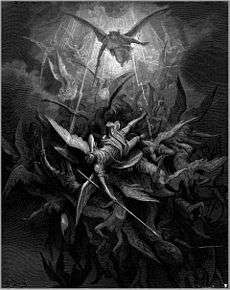
The motif of the fall of Satan and his angels can be found in Christian angelology and Christian art, and the concept of fallen angels (who, for rebelling against God, were degraded and condemned to a life of mischief or shame on earth or in a place of punishment) is widespread.[14] The Christian tradition has stories about angelic beings cast down from heaven by God, often presenting the punishment as inflicted in particular on Satan. As a result of linking this motif with the cited passage of the Book of Revelation, the casting of Satan down from heaven, which other versions of the motif present as an action of God himself, has become attributed to the archangel Michael at the conclusion of a war between two groups of angels, of whom, because of the mention of the dragon's tail casting a third of the stars of heaven to the earth, one third are supposed to have been on the side of Satan, in spite of the fact that the casting down of the stars (Revelation 12:4) is recounted as occurring before the start of the "war in heaven" (Revelation 12:7).
Lucifer's rebellion has been attributed to a number of motives, all of which stem from his great pride. These motives include:
- A refusal to bow down to mankind on the occasion of the creation of man as in the Armenian, Georgian, and Latin versions of the Life of Adam and Eve.[15] A similar view is held in Islamic tradition, in which Iblis refuses to bow down to Adam.[16]
- The culmination of a gradual distancing from God through use of free will (an idea of Origen of Alexandria).[17]
- A declaration by God that all were to be subject to his Son, the Messiah (as in Milton's Paradise Lost).[18]
Hebrew Bible parallels
Parallels are drawn to the passage in Isaiah 14:4-17 that mentions the "son of the morning" that had "fallen from heaven" and was "cast down to the earth". In verse 12 of this passage, the Hebrew word that referred to the morning star was translated into Latin as Lucifer. With the application to the Devil of the morning star story, "Lucifer" was then applied to him as a proper name. The name Lucifer, the Latin name (literally "Light-Bearer" or "Light-Bringer") for the morning star (the planet Venus in its morning appearances), is often given to the Devil in these stories. The brilliancy of the morning star—which eclipses all other stars, but is not seen during the night—may be what gave rise to myths such as the Babylonian story of Ethana and Zu, who was led by his pride to strive for the highest seat among the star-gods on the northern mountain of the gods (an image present also in Ezekiel 28:14), but was hurled down by the supreme ruler of the Babylonian Olympus.[19] Stars were then regarded as living celestial beings.[19][20] The Jewish Encyclopedia states that the myth concerning the Morning star was transferred to Satan by the first century before the Common Era, citing in support of this view the Life of Adam and Eve and the Slavonic Book of Enoch 29:4, 31:4, where Satan-Sataniel is described as having been one of the archangels. Because he contrived "to make his throne higher than the clouds over the earth and resemble 'My power' on high", Satan-Sataniel was hurled down, with his angels, and since then he has been flying in the air continually above the abyss. According to Jewish thought, the passage in Isaiah was used to prophesy the fate of the King of Babylon, who is described as aiming to rival God.[19]
Dead Sea Scrolls
Some scholars discern the concept of a war in heaven in certain Dead Sea Scrolls, namely, the War of the Sons of Light Against the Sons of Darkness, also known as the War Scroll (1QM and 4Q491-497), the Songs of the Sabbath Sacrifice, Song 5 (4Q402), and the Melchizedek document (11Q13).
In the War Scroll, according to Menahem Mansoor, the angels of light, who are identified with Michael, the prince of light, will fight in heaven against the angels of darkness, who are identified with Belial, while the Sons of Light fight the Sons of Darkness on earth, and during the last of the seven battles described in the scroll will come and help the Sons of Light win the final victory.[21]
James R. Davila speaks of Song 5 of the Songs of the Sabbath Sacrifice as describing "an eschatological war in heaven similar to that found in 11Q13 and to traditions about the archangel Michael in the War Rule and the book of Revelation".[22] He suggests that Melchizedek, who is mentioned both in the Melchizedek document and the fifth of the Songs of the Sabbath Sacrifice, may be a divine warrior who is involved in the conflict with the archangel Michael in the futurist sense.
That the Melchizedek document (11Q13) concerns a war in heaven is denied by Fred L. Horton, who remarks that "there is no hint in the extant portion of the 11Q Melchizedek of a revolt of heavenly beings against the heavenly council, and the only dissenting spirit is the traditional Belial";[23] the view of Davila, however, is that the document originally was about an eschatological war in heaven, with Melchizedek as angelic high priest and military redeemer.[24]
Gallery
- War in Heaven
-
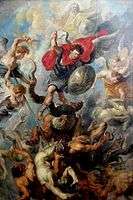
War in Heaven by Pieter Paul Rubens, 1619
-
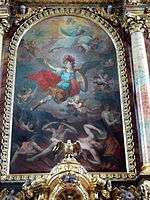
Michael fights rebel angels, by Johann Georg Unruhe 1793
-
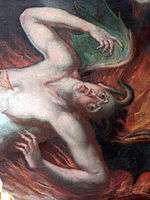
Detail of preceding
-

Michael fights rebel angels, by Sebastiano Ricci, c. 1720
-

Michael and Satan, by Guido Reni, c. 1636
-

St Michael's Victory over the Devil, by Jacob Epstein
-

The fall of the rebel angels, by Charles Le Brun, after 1680
-
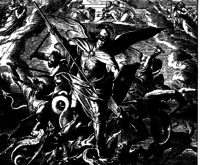
Michael and the Dragon. Die Bibel in Bildern (Revelation) engraving by Julius Schnorr von Carolsfeld, 1860.
-

Man with a full back tattoo. Michael and the Dragon. Adapted from Die Bibel in Bildern (Revelation) engraving.
References
- ↑ Revelation 12:7-9
- ↑ Joan Young Gregg (1997). Devils, Women, and Jews: Reflections of the Other in Medieval Sermon Stories. State University of New York. p. 28. ISBN 0-7914-3417-6.
- ↑ M. Eugene Boring; Fred B. Craddock (2004). The People's New Testament Commentary. Westminster: John Knox Press. p. 800. ISBN 0-664-22754-6.
- ↑
- ↑
- ↑ "Revelation 12 Matthew Henry's Commentary". Mhc.biblecommenter.com. Retrieved 2016-12-01.
- ↑ One hundred and seventy three sermons on several subjects: Volume 1, Page 137 Samuel Clarke, John Clarke, J. Leathley ((Dublin)), 1751 "7. that X. there was War in Heaven ; Michael and his Angels *- fought against the Dragon, and the Dragon fought and his Angels ... But the Meaning of this Passage is not literal, as if the Devil had Power to fight against the Angels or Ministers of God's government"
- ↑ Charles Edward Smith (1890). The world lighted: a study of the Apocalypse. "Of course not literal war, nor literally in heaven; not the actual clash of arms between Michael and his angels, and Satan and his wicked cohorts. But something on earth worthy to be represented by such a Titanic contest."
- ↑
- ↑ Jonathan Edwards; Sereno Edwards Dwight; David Brainerd. The Works of President Edwards: With a Memoir of His Life ... Books.google.com. p. 87. Retrieved 2016-12-01.
- ↑ Holweck, Frederick (1911). "St. Michael the Archangel". New York: The Catholic Encyclopedia. Retrieved January 28, 2010.
- ↑ Top, Brent L. (1992), "War in Heaven", in Ludlow, Daniel H, Encyclopedia of Mormonism, New York: Macmillan Publishing, pp. 1546–1547, ISBN 0-02-879602-0, OCLC 24502140
- ↑ The phrase "the devil and his angels" in Matthew 25:41 shows that the idea of angels associated with the devil preceded the writing of Revelation.
- ↑ "Fall Of Angels". JewishEncyclopedia.com. Retrieved 2016-12-01.
- ↑ Sections 14-15 of the Armenian,Georgian, and Latin versions of the Life of Adam and Eve
- ↑ Quran 7:11-12
- ↑ Oxford Dictionary of the Christian Church (Oxford University Press 2005 ISBN 978-0-19-280290-3), article Origen
- ↑
- 1 2 3 "Lucifer". JewishEncyclopedia.com. Retrieved 2016-12-01.
- ↑ Job 38:7
- ↑
- ↑ James R. Davila (2003). The Dead Sea scrolls as background to postbiblical Judaism and early Christianity: papers from an international conference at St. Andrews in 2001. Leiden: Brill Publishers. p. 252. ISBN 978-90-04-12678-7.
- ↑ Fred L. Horton (2005). The Melchizedek Tradition. Cambridge University Press. p. 81. ISBN 978-0-521-01871-5.
- ↑ Joseph L. Angel (2010). Otherworldly and Eschatological Priesthood in the Dead Sea Scrolls. Brill. pp. 153–154. ISBN 978-90-04-18145-8.
Further reading
- Christoph Auffarth, Loren T. Stuckenbruck (Eds.): The Fall of the Angels. Brill, Leiden 2004 (Themes in Biblical Narrative, 6), ISBN 90-04-12668-6.
- Mareike Hartmann: Höllen-Szenarien. Eine Analyse des Höllenverständnisses verschiedener Epochen anhand von Höllendarstellungen. Lit, Münster 2005 (Ästhetik – Theologie – Liturgik, 32), ISBN 3-8258-7681-0.
- Neil Forsyth, The Old Enemy: Satan & the Combat Myth (Princeton University Press) 1987.
External links
- The Fall of Satan, beliefnet.com
- The Fall of Angels, cfdevotionals.org
- A Rebellion in Heaven, christiancourier.com
- Lucifer, Jewish Encyclopedia
- Fall of Angels, Jewish Encyclopedia
- War in Heaven, warinheaven.com
